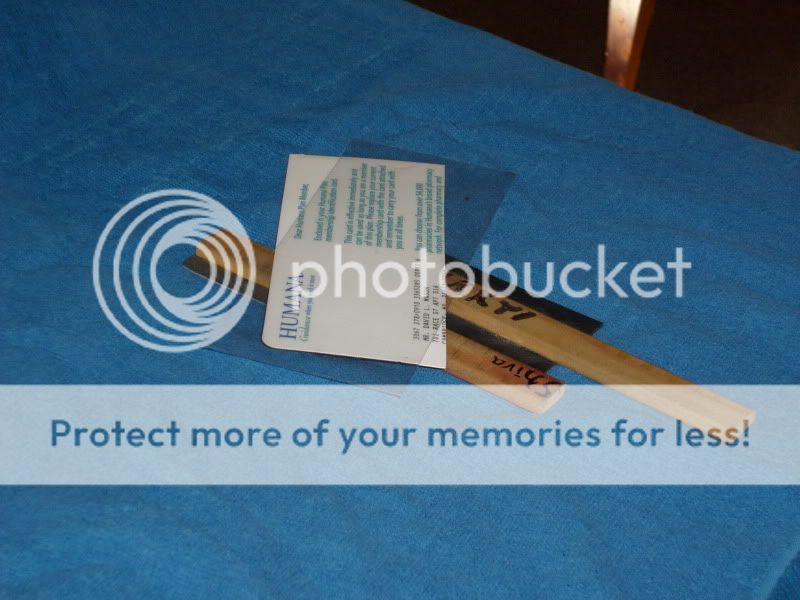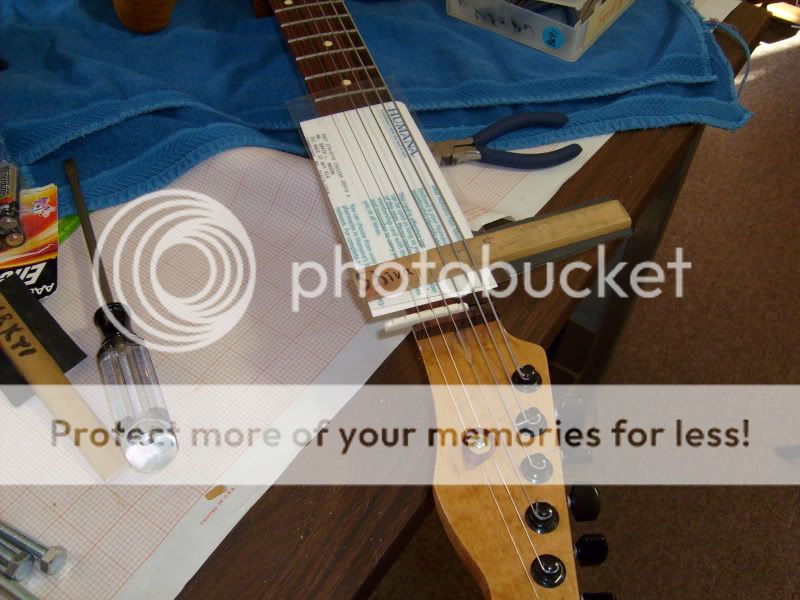DavyDave53
Senior Member
- Messages
- 201
All the Warmoth's neck nuts I've received have been a little on the high side but playable. I not worried about it as they will wear down with use.

Tony Ounsworth said:That's certainly true, but that's no good if you want to take it straight into a studio or play a gig with it. It'll just go out of tune.

Tony Ounsworth said:Here's the nut on mine by the way. It's hard to get a representative picture, but I think you can see that it's visibly high:
Regardless, the guitar tunes up normally to concert pitch. Play the first fret though, and it reads very sharp. That's what I mean by going out of tune in this case, it's not losing its pitch, it's just that the very act of fretting the string sends the note sharp. So whilst I can sit around at home strumming it, it's not a properly useable guitar - yet. I did use it a gig, as I was very keen to try it out, but I ran into problems in the lower reaches of the neck.
That's why I'm taking it to get Plekked. Although who knows when I'll get the time, it's been sitting in my office at work for over a week!
The low E string looks pretty good to me as far as what I can tell from the picture. Strings should never be any lower into the string slot than 1/2 of the string. Now since the nut slot needs to be deeper in order to eliminate the note at 1st fret from being sharp, then after deepening the slot the top surface of the nut will also have to be filed down to keep 1/2 of the string still showing. If it were me I would not tolerate the sharpness at the first fret and would get that sucker fixed. There is no way Warmoth can fine tune the nut slot depths because of all the factors involved. The nut slot depths are on the conservative side and require tweeking sometimes. Sometimes the buyer gets lucky and the slots are just right. Some don't like in your case. Like I said, I would not just live with it for long. You paid too much for that neck to have to compromise. Please note in no way am I slamming Warmoth for this. They are a wonderful company with quality products. The nut slot depths are impossible for them to perfect unless they were putting together the guitar for you. I'm gonna receive a new neck from them in a few days and have no problem with tweeking the nut if needed. Since starting this thread I have purchased all the tools, (gauged files, pippin file, nut saw, nut shaping files, nut slot polishing string, etc.) in order to do the work. I also have an extra Tusq xl nut available if I mess up. This is not a job everyone can do because of the skill and tools required but I will learn one way or the other. Building guitars is my new hobby and I refuse to let a luthier do anything for me. That's just the way I am. Always have always will. Lol That being said if I was not into the building but just needed or wanted a different neck for a quitar I would recommend a luthier to do the tweeking on your guitar. One last thing. I hope I'm not coming across as a know it all because I am far from it. I am just learning about this stuff and these forums are great for learning. There's so much I need to learn and I'm very appreciative of the help these forums provide. Also I'm very independent. lol Get's me in trouble sometimes. Good luck with that guitar Tony. Hope ya get it fixed soon. Wish ya lived closer I could experiment on yours instead of my neck. Lol Check this out something another member provided me with. Really good article. http://www.lutherie.net/nuts.htmlTony Ounsworth said:The biggest visual giveaway to me is how much of the low E string is visible above the nut, but also the fact that the tuner reads the F on the first fret as sharp when the low E is in tune.
Firstly, I agree with Cagey here. The reason for that "half the height" bit is that the string can't vibrate against the side of the nut slots - if there aren't any. :icon_biggrin: But if you use a whammy, play hard and especially, bend strings anywhere below the 7th fret, your strings will pop out. I expect that this is another leftover from violin setups, acoustic setup.... what it is, is a foolproof* way to eliminate buzzing, because it's a fast way to get potentially buzz-inducing material out of the way - a hangover from "professional" shop procedures where time is money, and if you do things the pokey way you're working for peanuts. Everything about that article cited above - http://www.lutherie.net/nuts.html - is great except the halfsies thing.Strings should never be any lower into the string slot than 1/2 of the string. Now since the nut slot needs to be deeper in order to eliminate the note at 1st fret from being sharp, then after deepening the slot the top surface of the nut will also have to be filed down to keep 1/2 of the string still showing.
Tusq is a delrin derivative, and it's supposed to let metal slide over it – it's bearing material. What this means for filing it is that if you press a little bit, the file slides right over it. And if you press just a bit harder, all of a sudden the file cuts very, very well. You need to know where that point is, just how your chosen tools interact with your chosen material. I find that abrasives may work better on some things (like delrin), I use wet/dry gray sandpaper, and the diamond-coated tools work the same way.I have purchased all the tools, (gauged files, pippin file, nut saw, nut shaping files, nut slot polishing string, etc.) in order to do the work. I also have an extra Tusq xl nut available if I mess up.


This is not a job everyone can do because of the skill and tools required but I will learn one way or the other. Building guitars is my new hobby and I refuse to let a luthier do anything for me.


